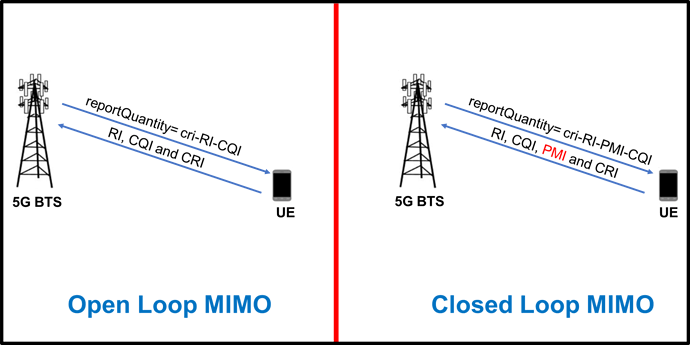-
My friend: Hey Ibrahim, where are you man? I didn’t see you for 4 weeks. I have a lot of questions for you.
- Me: Sorry, but I was travelling. So, let’s start answering your questions.
-
My friend: I was wondering what is the difference between open loop and closed loop MIMO in 5G?
- Me: Open loop MIMO will allow the UE to report the RI (Rank Indicator) and CQI (Channel Quality Indicator) only. While closed loop MIMO will allow the UE to report RI, CQI and PMI (Precoding Matrix Indicator). So, UE will suggest the no. of DL transmission layers to the 5G BTS using the RI and will also report the DL channel quality using CQI to suggest a specific DL MCS to be used, and will report PMI to suggest the used precoding matrix to improve the properties of the composite channel coefficient matrix in case of closed loop only.
-
My friend: But which is better to use; Open loop or closed loop MIMO?
- Me: Closed loop MIMO provides the transmitter with extra information to improve the performance of MIMO, but it generates more signaling overhead. While, open loop MIMO can be beneficial for high mobility scenarios which would cause a reported PMI to become invalid after only a short period of time and hence it is better to use open loop MIMO in case of high mobility.
-
My friend: But, how do the UE know which type to use of open and closed loop MIMO?
- Me: This will be done indirectly as the 5G BTS will set the reportQuantity IE inside the CSI-reportConfig parameter structure to either “cri-RI-PMI-CQI” or “cri-RI-CQI”. This means that the UE will report RI, CQl and PMI for MIMO, in combination with the CRI (CSI Reference Signal Resource Indicator) for Beam Management which means closed loop MIMO or only will report RI and CQI in in combination with CRI for the latter case which means open loop MIMO.
-
My friend: Thank you very much. You made it very clear.
- Me: You are most welcome.

Source: Ibrahim Sayed, PMP on LinkedIn: #5g #5gnr #5gtechnology | 35 comments